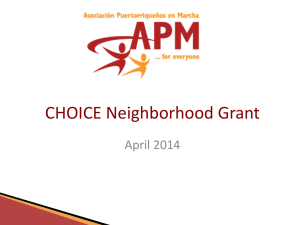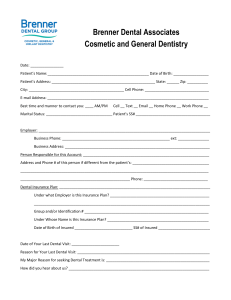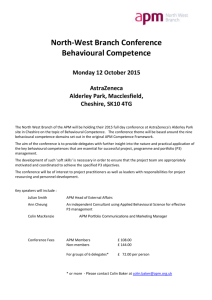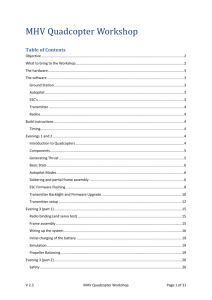APM Touches Report - Oregon School
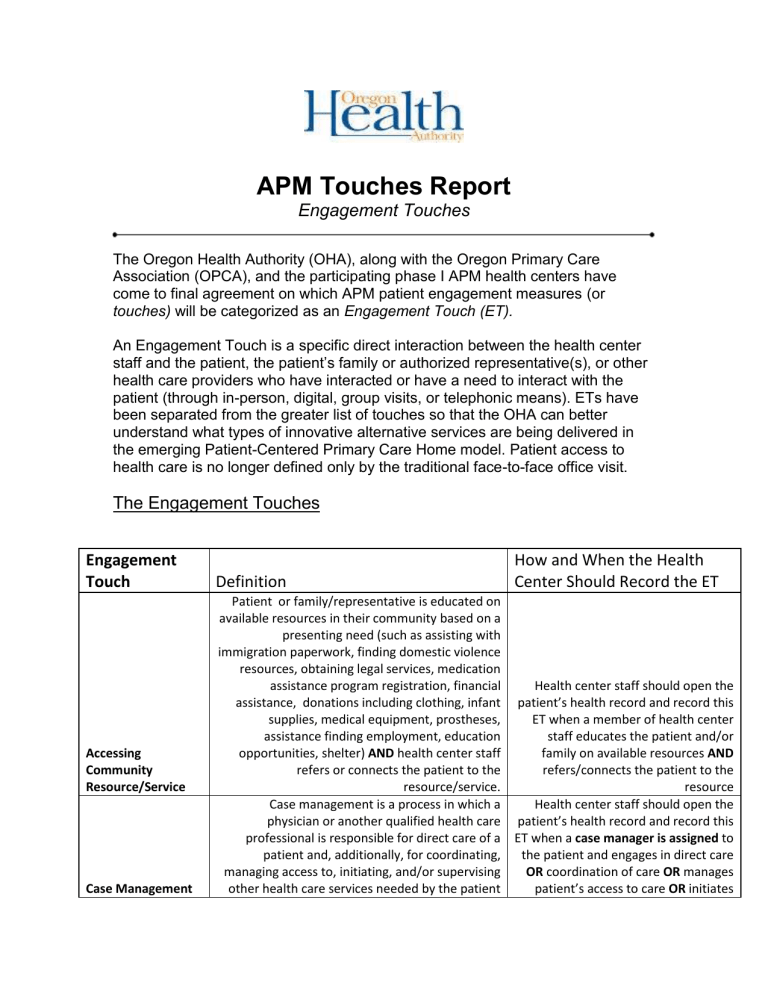
APM Touches Report
Engagement Touches
The Oregon Health Authority (OHA), along with the Oregon Primary Care
Association (OPCA), and the participating phase I APM health centers have come to final agreement on which APM patient engagement measures (or
touches)
will be categorized as an
Engagement Touch (ET).
An Engagement Touch is a specific direct interaction between the health center staff and the patient, the patient’s family or authorized representative(s), or other health care providers who have interacted or have a need to interact with the patient (through in-person, digital, group visits, or telephonic means). ETs have been separated from the greater list of touches so that the OHA can better understand what types of innovative alternative services are being delivered in the emerging Patient-Centered Primary Care Home model. Patient access to health care is no longer defined only by the traditional face-to-face office visit.
The Engagement Touches
Engagement
Touch
How and When the Health
Center Should Record the ET
Accessing
Community
Resource/Service
Case Management
Definition
Patient or family/representative is educated on available resources in their community based on a presenting need (such as assisting with immigration paperwork, finding domestic violence resources, obtaining legal services, medication assistance program registration, financial assistance, donations including clothing, infant supplies, medical equipment, prostheses, assistance finding employment, education opportunities, shelter) AND health center staff refers or connects the patient to the resource/service.
Case management is a process in which a physician or another qualified health care professional is responsible for direct care of a patient and, additionally, for coordinating, managing access to, initiating, and/or supervising other health care services needed by the patient
Health center staff should open the patient’s health record and record this
ET when a member of health center staff educates the patient and/or family on available resources AND refers/connects the patient to the resource
Health center staff should open the patient’s health record and record this
ET when a case manager is assigned to the patient and engages in direct care
OR coordination of care OR manages patient’s access to care OR initiates
Education Provided in Group Setting
Exercise Class
Participant
MyChart Encounter
Support Group
Participant
Telephone Visit
APM Pilot
– Engagement Touches
Health center staff educate a group of patients on health promotion activities (such as parenting/pregnancy classes, health fairs, and teaching kitchens/healthy cooking classes)
The health center or affiliated group hosts a class available to the health center’s patients. The health center is able to verify that the patient attended an exercise class (including a low-impact walking group, yoga, Zumba, and Tai Chi).
A web portal application within the EPIC electronic health record system that allows patients to connect directly with their provider and care team over the internet, securely.
Patient and/or family attends an organized grouping of people with common experiences and concerns, who provide emotional and moral support for one another.
Call with patient (unrelated to tobacco cessation
or maternity case management) about medical/dental/MH/A&D condition or medications to discuss or create care plan, treatment options, and/or health promotion activities and/or supervises other health care services needed by the patient
Health center staff should open the patient’s health record and record this
ET when they have verified that the individual patient attended the education class/event
Health center staff should open the patient’s health record and record this
ET when they have verified that the individual patient attended the exercise class/event
Automatically records as ET when a message is sent from the patient, or the patient’s provider sends a message to them
Health center staff should open the patient’s health record and record this
ET when they have verified patient attended a support group hosted by their health center or referred to by the health center. Verification may come from the patient
Health center staff should open the patient’s health record and record this
ET when health center staff speaks with patient about medical/dental/MH/substance use condition or medications AND discusses or creates care plan OR discusses treatment options OR discusses health promotion activities
Oregon FQHC APM Pilot
2
Page
4/12/2020
APM Pilot
– Engagement Touches
Warm Hand-off
(non-billable)
Home Visit (nonbillable)
Coordinating Care:
Clinical Follow-up and Transitions in
Care Setting
Coordinating Care:
Dental
Coordinating Care:
Oregon FQHC APM Pilot
3
Primary care provider directly introduces the patient to the behavioral health, mental health, dental health, social worker, or substance use provider at the time of the medical visit
Health center staff visits the patient’s home for reasons unrelated to assessment, diagnosis, treatment, or Maternity Case Management. Nonbillable home visits include but are not limited to:
A community health worker visiting patient’s residence to support the family, a parenting class, a clinical pharmacist visiting to assist with medication management and reconciliation
Health center staff speaks with patient (including family or representative) or speaks with another health professional regarding the patient’s recent care at an outside health organization (ER, hospital, long-term care facility, etc.) to:
1) Arrange a follow-up visit at the health center or other ET, or
2) Speaks with patient to update care plan and educate on preventive health measures, or
Assists patient with a transition in their care setting
During primary care visit, patient and health center staff identify that patient has dental health care needs, and coordinates with dental professionals by assistance with dental appointment set-up or speaking directly with the dental provider regarding patient’s dental care needs
Health center staff exchanges patient
Health center staff should open the patient’s health record and record this
ET when patient is successfully accepted and services are provided as defined in the definition section
Health center staff should open the patient’s health record and record this
ET upon completion of the home visit as defined in the definition section
Health center staff should open the patient’s health record and record this
ET when they have verified the patient received or needs to receive health services from a different provider, and completed 1, 2, or 3 listed in the definition section.
Health center staff should open the patient’s health record and record this
ET when they have confirmed that the primary care provider set-up a dental appointment and/or had spoken with the dental provider
Health center staff should open the
Page
4/12/2020
Information
Management
Flowsheet
Health Education
Supportive
Counseling
Panel Management
Outreach
Transportation
Assistance
Oregon FQHC APM Pilot
4
APM Pilot
– Engagement Touches health information with hospitals, mental health providers, specialty providers, dental providers, or any other health provider that is necessary to effectively coordinate and improve a patient’s health care and health outcomes
A document flowsheet based on various health screening responses that inform logical next steps
(including SBIRT, GAD 7, Ages & Stages, Edinburgh
Postnatal Depression, and PHQ9 screenings)
Services provided by a physician or other qualified health care professional for the purpose of promoting health and preventing illness or injury.
Risk factor reduction services are used for persons with specific illness for which the counseling might otherwise be used as part of treatment.
Preventive medicine counseling and risk factor reduction interventions will vary with age and should address such issues as family problems, diet and exercise, substance use, sexual practices, injury prevention, dental health, and diagnostic and laboratory test results available at the time of the encounter. Behavior change interventions are for persons who have a behavior that is often considered an illness itself, such as tobacco use and addiction, substance abuse/misuse, or obesity. Behavior change services involve specific validated interventions of assessing readiness for change and barriers to change, advising a change in behavior, assisting by providing specific suggested actions and motivational counseling, and arranging for services and follow-up patient’s health record and record this
ET when health center staff speaks with provider outside of the patient’s care team AND sends or receives pertinent health information for the patient
Health center staff should open the patient’s health record and record this
ET when the screening has been completed
Health center staff uses dedicated time to direct proactive care for their empaneled patients, uses staff support to conduct outreach, and leverages new panel-based information technology tools.
Health center provides direct assistance to a patient by a staff member or contractor in which
Health center staff should open the patient’s health record and record this
ET when a member of the health center staff engages in the activities described in the definition.
Health center staff should record this
ET when staff proactively determine patient’s gaps in care AND reach out to the patient/family/representative/external provider regarding preventive services, chronic illness management, their care plan, problem list, health goals, and/or treatment options. Outreach efforts must be specific to patient’s gaps in care.
Health center staff should open the patient’s health record and record this
Page
4/12/2020
Home Care Visit
Encounter
Telemedicine
Encounter
APM Pilot
– Engagement Touches access barriers are reduced for a patient through transportation resources and services
The Division considers a home visit for assessment, diagnosis, treatment or MCM as an encounter
The use of telephonic or electronic communications of medical information from one site to another to improve a patient’s health status. See OAR 410-130-0610
ET after staff identify patient has an access barrier in the realm of transportation AND delivers the resource/service that will reduce the transportation barrier
Health center staff should open the patient’s health record and record this
ET when they visited a patient’s residence or facility for assessment, diagnosis, treatment, or Maternity
Case Management.
Health center staff should open the patient’s health record and record this
ET when:
Patient consultations using videoconferencing, a synchronous (live two-way interactive) video transmission resulting in real time communication between a medical practitioner located in a distant site and the client being evaluated and located in an originating site OR
Telephonic codes may be used in lieu of videoconferencing codes, if videoconferencing equipment is not available.
(5) Telephone and E-mail billing requirements: Use the Evaluation and
Management (E/M) code authorized in the HSC practice guideline, unless otherwise authorized in OAR 410-120-
1200.
Oregon FQHC APM Pilot
5
Page
4/12/2020


